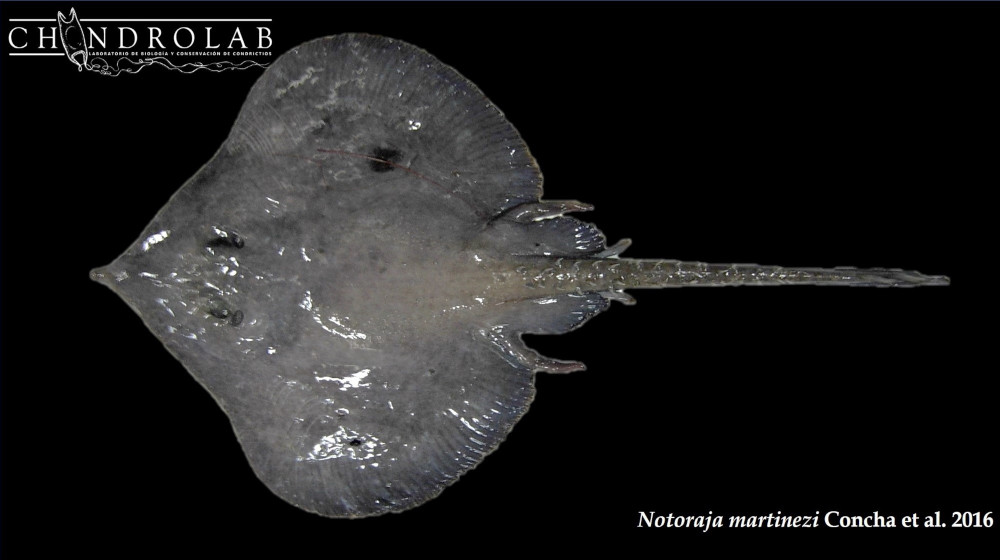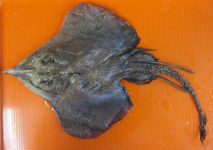Notoraja martinezi
Concha, Ebert & Long, 2016
Classification: Elasmobranchii Rajiformes Arhynchobatidae
Reference of the original description
Notoraja martinezi sp. nov., a new species of deepwater skate and the first record of the genus Notoraja Ishiyama, 1958 (Rajiformes: Arhynchobatidae) from the eastern Pacific Ocean. Zootaxa, 4098(1), 179–190
Notoraja martinezi sp. nov., a new species of deepwater skate and the first record of the genus Notoraja Ishiyama, 1958 (Rajiformes: Arhynchobatidae) from the eastern Pacific Ocean. Zootaxa, 4098(1), 179–190
Description :
Citation: Notoraja martinezi Concha, Ebert & Long, 2016: In: Database of modern sharks, rays and chimaeras, www.shark-references.com, World Wide Web electronic publication, Version 12/2025
Please send your images of "Notoraja martinezi" to info@shark-references.com

Notoraja martinezi Concha, Ebert & Long, 2016, male holotype (MEPN 18198), fresh © Francisco Concha, Condrolab, Universidad de Valparaíso, Chile

Notoraja martinezi Concha, Ebert & Long, 2016, male holotype (MEPN 18198), fresh © Francisco Concha, Condrolab, Universidad de Valparaíso, Chile
Common names
 raya de púas,
raya de púas,  Barbedwire-tailed skate
Barbedwire-tailed skate
 raya de púas,
raya de púas,  Barbedwire-tailed skate
Barbedwire-tailed skate
Short Description
Original Diagnosis after CONCHA, EBERT & LONG, 2016 [23902]: A heart-shaped, medium-size species of Notoraja. Dark brownish dorsal and ventral surface; disc slightly wider 54.7 (51.7–55.2) %TL than long 51.6 (49.0–54.3) %TL. Dorsal head length 21.3 (18.9–20.4) %TL; interspiracular width 6.3 (6.6–7.6) %TL; internarial space 8.4 (6.6–7.9) %TL; preorbital length 14.9 (13.0–14.9) %TL, 4.4 (3.8–4.9) times orbit length and 3.0 (2.9–3.3) times distance between eyes (interorbital space); tail width at pelvic fin axil 1.5 (1.3–1.4) times its height; single, strong, hook-like, angled posteriorly preorbital thorn; disk with small, fine denticles randomly distributed, slightly more abundant on the sides of the caudal region; claspers long (cloacal length) 23.8% TL and slim; tail long and slender, covered with abundant strong, thin, non aligned and posteriorly angled thorns, which differs from all other described species of the genus; thin lateral tail folds merging at tail axil, thinner than tail width at any point and enlarged posteriorly; nasal lobes expanded, nasal curtain maximum width 8.4 (7.8–9.5) %TL; anterior pelvic-fin lobe longer than posterior 13.1 (16.2–16.8) %TL and 10.1 (7.8–9.8)% TL when straightened (shorter than posterior in natural position though); total pectoral-fin radials 65 (63–65); Monospondylus centra 25 (24–26); predorsal diplospondylous centra 58 (60–65); total predorsal centra 83 (85–91); caudal centra 20 (22-25) total centra 118 (123–128).
Original Diagnosis after CONCHA, EBERT & LONG, 2016 [23902]: A heart-shaped, medium-size species of Notoraja. Dark brownish dorsal and ventral surface; disc slightly wider 54.7 (51.7–55.2) %TL than long 51.6 (49.0–54.3) %TL. Dorsal head length 21.3 (18.9–20.4) %TL; interspiracular width 6.3 (6.6–7.6) %TL; internarial space 8.4 (6.6–7.9) %TL; preorbital length 14.9 (13.0–14.9) %TL, 4.4 (3.8–4.9) times orbit length and 3.0 (2.9–3.3) times distance between eyes (interorbital space); tail width at pelvic fin axil 1.5 (1.3–1.4) times its height; single, strong, hook-like, angled posteriorly preorbital thorn; disk with small, fine denticles randomly distributed, slightly more abundant on the sides of the caudal region; claspers long (cloacal length) 23.8% TL and slim; tail long and slender, covered with abundant strong, thin, non aligned and posteriorly angled thorns, which differs from all other described species of the genus; thin lateral tail folds merging at tail axil, thinner than tail width at any point and enlarged posteriorly; nasal lobes expanded, nasal curtain maximum width 8.4 (7.8–9.5) %TL; anterior pelvic-fin lobe longer than posterior 13.1 (16.2–16.8) %TL and 10.1 (7.8–9.8)% TL when straightened (shorter than posterior in natural position though); total pectoral-fin radials 65 (63–65); Monospondylus centra 25 (24–26); predorsal diplospondylous centra 58 (60–65); total predorsal centra 83 (85–91); caudal centra 20 (22-25) total centra 118 (123–128).
Size / Weight / Age
475 mm TL for an adult male, while the largest female is 346 mm TL (types) [23902]
475 mm TL for an adult male, while the largest female is 346 mm TL (types) [23902]
Dentition
Tooth rows in upper jaw 42 (38–44); tooth series in upper jaw 5 (4–5); tooth rows in lower jaw 38 (36–42); tooth series in lower jaw 12 (5–7) [23902]
Tooth rows in upper jaw 42 (38–44); tooth series in upper jaw 5 (4–5); tooth rows in lower jaw 38 (36–42); tooth series in lower jaw 12 (5–7) [23902]
Remarks
shark-references Species-ID=14561;
shark-references Species-ID=14561;

















